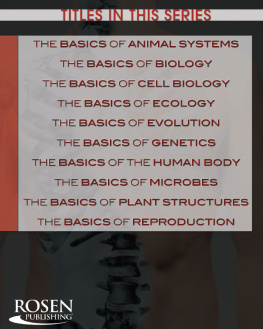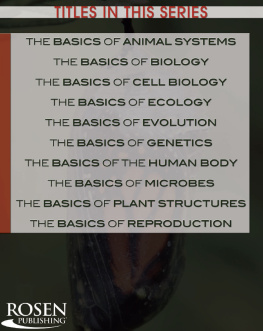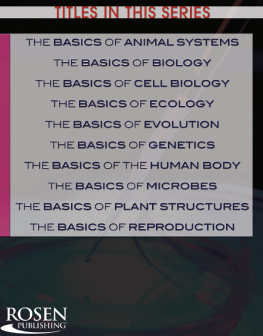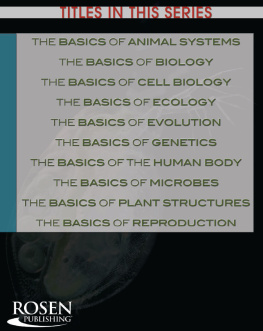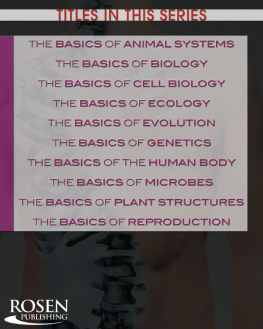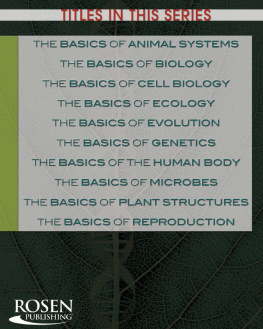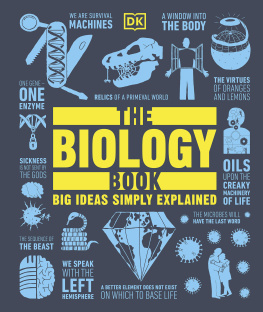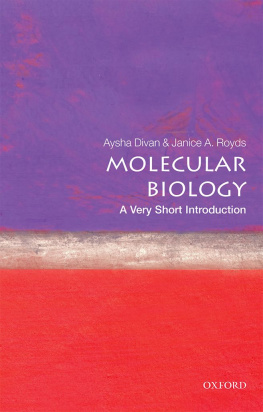This edition published in 2014 by:
The Rosen Publishing Group, Inc.
29 East 21st Street
New York, NY 10010
Additional end matter copyright 2014 by The Rosen Publishing Group, Inc.
All rights reserved. No part of this book may be reproduced in any form without permission in writing from the publisher, except by a reviewer.
Library of Congress Cataloging-in-Publication Data
Wanjie, Anne.
The basics of biology/Anne Wanjie.1st ed.New York:
Rosen, 2014
p. cm.(Core concepts)
Includes bibliographical references and index.
ISBN 978-1-4777-0554-4 (library binding)
1. BiologyJuvenile literature. I. Title.
QH309.2 .W36 2014
Manufactured in the United States of America
CPSIA Compliance Information: Batch #S13YA: For further information, contact Rosen Publishing, New York, New York, at 1-800-237-9932.
2004 Brown Bear Books Ltd.
CONTENTS
CHAPTER 1: THE ESSENCE OF L IFE
CHAPTER 2: BIOLOGICAL DIVERSITY
CHAPTER 3: LIFE AT THE MOLECULAR LEVEL
CHAPTER 4: FIELD STUDY
CHAPTER 5: LABORATORY WORK
CHAPTER 6: INTERPRETING THE DATA
CHAPTER 7: PUTTING DISCOVERIES TO WORK
CHAPTER 8: BIOGRAPHY: ALEXANDER FLEMING
GLOSSARY
FOR MORE INFORMATION
FOR FURTHER READING
INDEX
CHAPTER ONE
THE ESSENCE OF LIFE
Biology is the study of all aspects of living things great and small, from the chemicals that life forms are made of to where and how the life forms live. Scientists who specialize in biology are called biologists.
T he history of biology begins more than 2,500 years ago, in the early civilizations of China, Europe, India, and the Middle East. In Western countries ancient Greek ideas about living creatures became the basis for the study of biology. Most of these ideas are now proven to be incorrect but were accepted for more than 2,000 years.
A marine biologist studies a coral reef off the coast of Fiji to determine the state of its health.
BLOOD AND PHLEGM
The ancient Greeks believed that everything on Earth was made of four elements: earth, air, fire, and water. The philosopher Hippocrates (460377 bce)suggested that people were made of these elements plus four fluids called humors. Two of these humors were blood (produced by the heart) and phlegm (from the brain). The other two were yellow bile (from the liver) and black bile (from the spleen). The levels of humors were thought to be responsible for a persons mental and physical health. This belief formed the basis of Western medicine for more than 2,000 years.
One question that ancient civilizations tried to answer was What is the difference between living and nonliving things? Some thought that the answer lay in different types of spirit or soul. Nonliving things had low-grade spirits. Plants had highergrade spirits, animals had better-quality spirits than plants, and people had the highest grade of spirit.
In the 17th century many scientists began to doubt the old Greek ideas. They would no longer accept them just because they seemed to work. So, they developed new ideas backed up by the results of careful experiments. Their work laid the foundations of modern biology.
SPONTANEOUS GENERATION
A common belief in ancient times was that nonliving materials could create life. They did so by a mysterious process called spontaneous generation. When people saw hordes of flies coming from dead animals, they thought that the flesh had created the flies. They did not notice that the flies had hatched from eggs laid in the dead animal by female flies. For similar reasons they thought that frogs came from mud.
RECIPE FOR MICE
The chemist Johannes van Helmont (ce 15791644) made important discoveries about gases. But he also believed in spontaneous generation. He said that to make mice, you put dirty clothes in a barrel and add some wheat. After a few days the mixture of dirty clothes and wheat will produce mice.
THE TRUTH ABOUT FLIES
In 1668 the Italian physician Francisco Redi (16261697) disproved the old idea that rotting flesh created flies. He put one piece of meat into a flask with no lid. At the same time, he put another piece of meat into a flask and covered it with a lid. The lid kept flies from getting in. The meat in the open flask was soon seething with larvae, which turned into flies. But no maggots or flies emerged from the meat in the covered flask.
VITALISM
An idea called vitalism took root in Europe in the early 17th century. According to this idea, living things had a vital force that gave them life. Nonliving things lacked this force. The chemicals that made up living things, or came from them, also carried some of this magical forceso it was impossible to make them artificially. The vitalism theory began to fall apart in 1828, when the German chemist Friedrich Whler (18001882) produced one of these chemicals in his laboratory. The substance he made, called urea, is a nitrogen-based substance present in urine.
The invention of the microscope in the mid-17th century was one of the biggest technical advances in biology. It allowed researchers to look at the structure of living things and see details invisible to the naked eye. By the end of the century scientists using microscopes had discovered plant and animal cells.
Like animals and other living organisms, plants behave and respond to what happens around them. Stems grow upward and roots grow downward because the plant senses gravity. Leaves turn to face the light because the plant can sense the lights direction.
LIVING OR NOT LIVING?
Today biologists use a simple set of rules to decide if something is living or nonliving. For something to qualify as an organism (any type of living thing), it must feed, respire, excrete, move, grow, reproduce, and sense its environment. Anything that carries out all seven of these functions is a living organism. If it does not perform all seven functions, it is not a living organism.
ARE VIRUSES LIFE FORMS?
The cells of all living organisms contain genetic (inherited) material in the form of RNA (ribonucleic acid) and DNA (deoxyribonucleic acid). Genetic material contains a complex chemical code. This code controls the growth, function, and reproduction of each cell and of the whole organism. Viruses are short strands of genetic material wrapped in a coat of protein. They invade the cells of organisms and mix the cells genetic material with their own. They do this to reproduce, creating copies of themselves that go on to invade other cells. Although viruses contain genetic material and reproduce, most scientists do not class them as living organisms.
That is because they have no means of respiration or excretion. Viruses get all their energy from the cells that they invade.
DEFINITION OF LIFE


